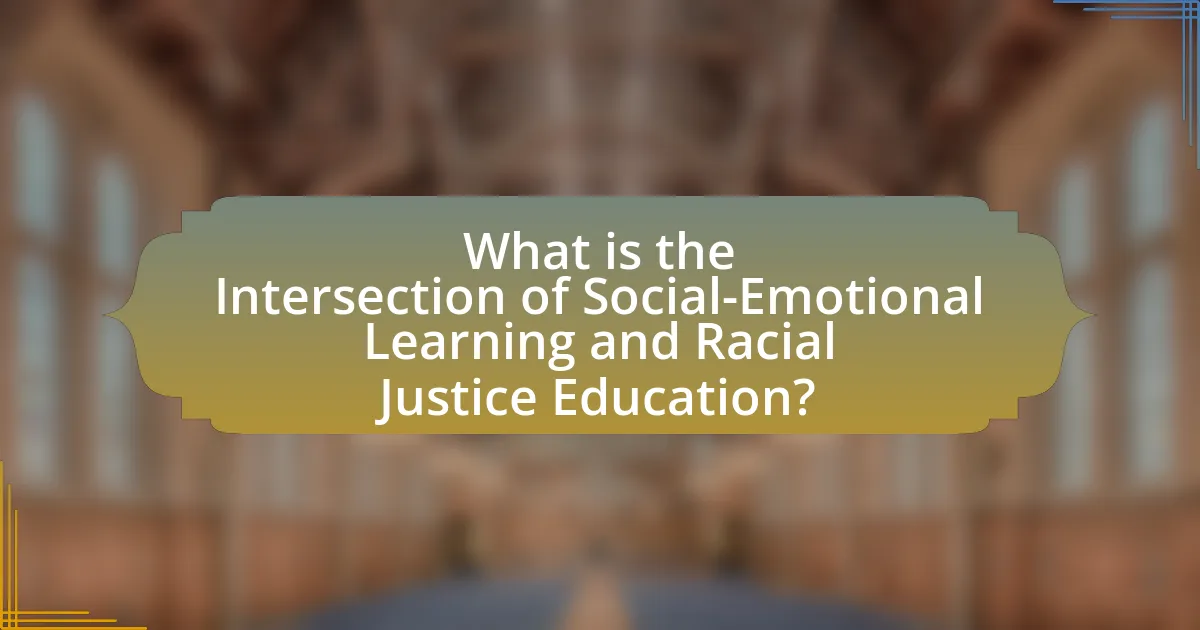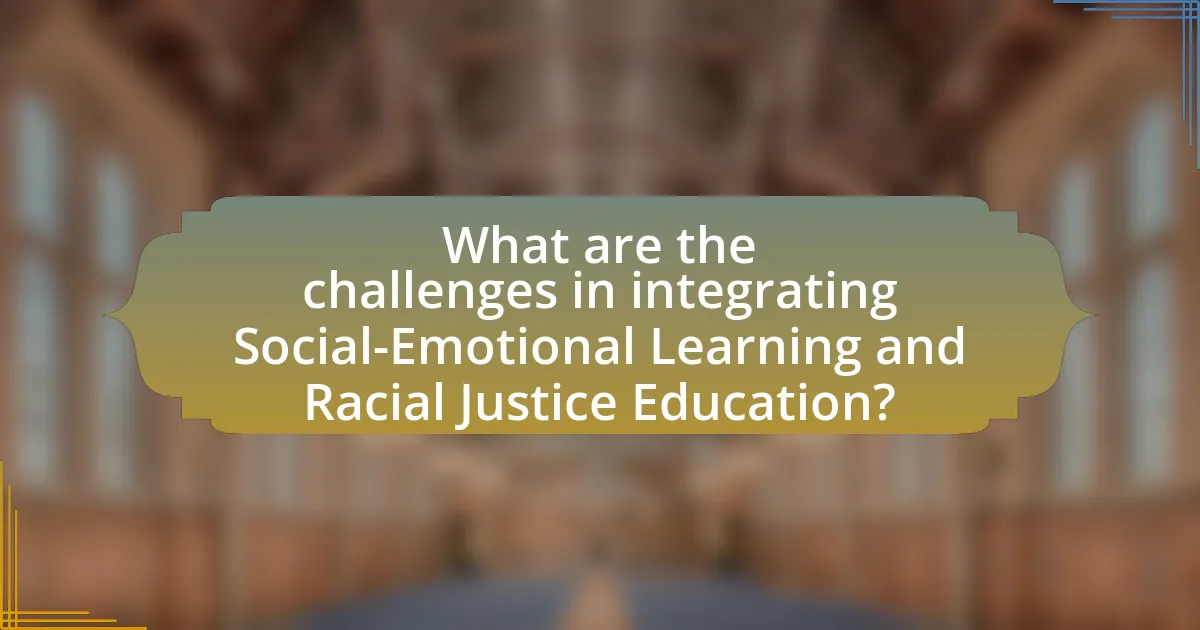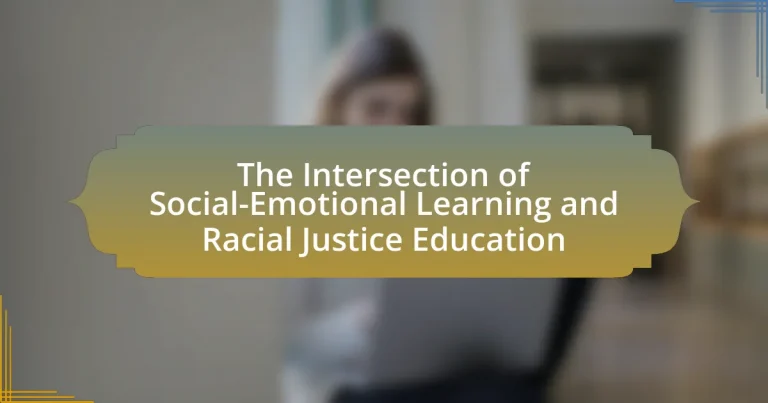The article examines the intersection of Social-Emotional Learning (SEL) and Racial Justice Education, highlighting how these frameworks can be integrated to foster emotional intelligence and address systemic racism. It outlines the core principles of SEL, such as self-awareness and relationship skills, alongside key concepts of Racial Justice Education, including equity and anti-racism. The discussion emphasizes the importance of this intersection in promoting student well-being, enhancing empathy, and creating equitable educational environments. Additionally, it addresses the challenges and misconceptions that hinder effective integration, while providing strategies for educators to implement these approaches in the classroom.

What is the Intersection of Social-Emotional Learning and Racial Justice Education?
The intersection of social-emotional learning (SEL) and racial justice education involves integrating emotional intelligence and interpersonal skills with an understanding of systemic racism and social equity. SEL focuses on developing self-awareness, self-management, social awareness, relationship skills, and responsible decision-making, which are essential for fostering empathy and understanding among diverse groups. Racial justice education emphasizes recognizing and addressing racial inequalities and injustices, promoting equity, and empowering marginalized communities. Together, these frameworks create a holistic approach that not only nurtures individual emotional growth but also cultivates a collective responsibility towards social justice, thereby equipping students with the skills to challenge and change inequitable systems.
How do Social-Emotional Learning and Racial Justice Education relate to each other?
Social-Emotional Learning (SEL) and Racial Justice Education are interconnected as both aim to foster understanding, empathy, and social awareness among students. SEL focuses on developing emotional intelligence, self-regulation, and interpersonal skills, which are essential for addressing issues of racial injustice. Racial Justice Education, on the other hand, seeks to raise awareness about systemic inequalities and promote equity, encouraging students to engage in critical discussions about race and identity. Research indicates that integrating SEL into Racial Justice Education enhances students’ ability to navigate complex social dynamics, fostering a more inclusive and equitable learning environment. For instance, studies show that students who participate in SEL programs demonstrate improved attitudes towards diversity and increased empathy, which are crucial for understanding and combating racial injustices.
What are the core principles of Social-Emotional Learning?
The core principles of Social-Emotional Learning (SEL) include self-awareness, self-management, social awareness, relationship skills, and responsible decision-making. These principles are designed to foster emotional intelligence and interpersonal skills, which are essential for personal and academic success. Research indicates that SEL programs can lead to improved academic performance, better behavior, and enhanced emotional well-being among students, as evidenced by a meta-analysis conducted by Durlak et al. (2011) in the journal “Child Development,” which found that students participating in SEL programs showed an 11 percentile-point gain in academic achievement compared to their peers.
What are the key concepts of Racial Justice Education?
The key concepts of Racial Justice Education include equity, anti-racism, cultural competence, and critical consciousness. Equity focuses on ensuring fair treatment and access to resources for all students, addressing systemic inequalities. Anti-racism involves actively challenging and dismantling racist policies and practices within educational systems. Cultural competence emphasizes understanding and respecting diverse cultural backgrounds, fostering an inclusive environment. Critical consciousness encourages students to analyze social injustices and engage in activism to promote change. These concepts are essential for creating an educational framework that supports all students and addresses historical and systemic inequities.
Why is the intersection of these two fields important?
The intersection of social-emotional learning (SEL) and racial justice education is important because it fosters a holistic approach to student development and equity. By integrating SEL, educators can enhance students’ emotional intelligence, empathy, and interpersonal skills, which are crucial for understanding and addressing racial injustices. Research indicates that SEL programs can lead to improved academic performance and reduced behavioral issues, while racial justice education equips students with the critical awareness needed to challenge systemic inequalities. Together, these fields promote a more inclusive and supportive learning environment, ultimately contributing to the development of socially responsible citizens who are equipped to advocate for equity and justice in their communities.
How does this intersection impact student well-being?
The intersection of social-emotional learning and racial justice education positively impacts student well-being by fostering a supportive environment that promotes emotional resilience and social awareness. This integration helps students develop critical skills such as empathy, self-regulation, and cultural competence, which are essential for navigating diverse social contexts. Research indicates that schools implementing both frameworks report improved student engagement and reduced behavioral issues, contributing to a healthier school climate. For instance, a study by the Collaborative for Academic, Social, and Emotional Learning (CASEL) found that effective social-emotional programs can lead to a 23% increase in student academic performance and a significant decrease in emotional distress, highlighting the importance of this intersection for overall student well-being.
What role does this intersection play in promoting equity in education?
The intersection of social-emotional learning (SEL) and racial justice education plays a crucial role in promoting equity in education by fostering an inclusive environment that addresses the emotional and social needs of all students, particularly those from marginalized backgrounds. This integration helps students develop critical skills such as empathy, self-awareness, and cultural competence, which are essential for understanding and addressing systemic inequalities. Research indicates that SEL programs can lead to improved academic outcomes and reduced behavioral issues, particularly in diverse classrooms, thereby supporting equitable educational experiences. For instance, a study by Durlak et al. (2011) found that students participating in SEL programs showed an 11 percentile-point gain in academic achievement compared to their peers. This evidence underscores the effectiveness of combining SEL with racial justice education to create a more equitable educational landscape.

What are the challenges in integrating Social-Emotional Learning and Racial Justice Education?
Integrating Social-Emotional Learning (SEL) and Racial Justice Education faces several challenges, primarily due to differing educational priorities and systemic biases. Educators often prioritize academic achievement over emotional and social development, which can lead to insufficient focus on SEL. Additionally, systemic racism within educational institutions can hinder the effective implementation of racial justice principles, as educators may lack training or resources to address these issues comprehensively. Research indicates that without proper training, teachers may struggle to facilitate discussions on race and emotions, leading to discomfort and avoidance of critical topics. Furthermore, the lack of culturally relevant materials can impede the integration of SEL and racial justice, as students may not see their experiences reflected in the curriculum. These challenges highlight the need for intentional strategies that align SEL with racial justice to create an inclusive educational environment.
What barriers exist in implementing these educational approaches together?
Barriers in implementing social-emotional learning (SEL) and racial justice education together include a lack of teacher training, insufficient curriculum resources, and systemic biases within educational institutions. Teachers often lack the necessary training to effectively integrate SEL with racial justice concepts, leading to ineffective delivery of these intertwined approaches. Additionally, many schools do not have access to comprehensive curriculum resources that address both SEL and racial justice, which hinders the development of cohesive lesson plans. Systemic biases, such as institutional racism and inequitable funding, further complicate the implementation process, as they can create environments that are not conducive to open discussions about race and emotions. These barriers collectively impede the successful integration of SEL and racial justice education in classrooms.
How do systemic inequalities affect the integration process?
Systemic inequalities significantly hinder the integration process by perpetuating disparities in access to resources, opportunities, and social networks. These inequalities manifest in various forms, such as economic disadvantage, educational inequities, and social exclusion, which collectively create barriers for marginalized groups seeking to integrate into broader societal frameworks. For instance, research by the National Equity Project highlights that students from underrepresented backgrounds often face systemic obstacles in educational settings, limiting their ability to engage fully and benefit from integration initiatives. This lack of equitable access to quality education and support services directly impacts their social-emotional development and overall integration success.
What misconceptions hinder the understanding of both fields?
Misconceptions that hinder the understanding of social-emotional learning (SEL) and racial justice education include the belief that SEL is solely about individual emotional regulation and that racial justice education is only relevant in discussions of history. These misconceptions limit the recognition of SEL as a framework that fosters collective empathy and social responsibility, which are essential for addressing systemic inequalities. Additionally, viewing racial justice education as a historical topic neglects its ongoing relevance in contemporary social contexts, where understanding emotional and social dynamics is crucial for fostering inclusive environments. Research indicates that integrating SEL with racial justice education enhances students’ ability to engage with complex social issues, promoting both personal and collective growth.
How can educators overcome these challenges?
Educators can overcome challenges in integrating social-emotional learning (SEL) with racial justice education by implementing culturally responsive teaching practices. Culturally responsive teaching acknowledges and incorporates students’ cultural backgrounds into the learning process, which enhances engagement and understanding. Research indicates that when educators use culturally relevant materials and strategies, students from diverse backgrounds show improved academic performance and social-emotional skills (Ladson-Billings, 1994). Additionally, professional development focused on SEL and racial equity equips educators with the necessary tools to address biases and foster inclusive environments. Studies show that ongoing training in these areas leads to more effective teaching practices and better student outcomes (Zins & Elias, 2006).
What strategies can be employed to effectively merge these approaches?
To effectively merge social-emotional learning (SEL) and racial justice education, educators can implement integrated curricula that emphasize both emotional intelligence and social equity. This approach involves designing lesson plans that incorporate SEL competencies—such as self-awareness and empathy—while simultaneously addressing issues of racial injustice and systemic inequality. Research indicates that when students engage in discussions about race and identity through the lens of SEL, they develop a deeper understanding of their own emotions and the experiences of others, fostering a more inclusive classroom environment. For instance, a study by the Collaborative for Academic, Social, and Emotional Learning (CASEL) highlights that integrating SEL with social justice themes enhances students’ critical thinking and promotes a sense of belonging among diverse student populations.
How can professional development support this integration?
Professional development can support the integration of social-emotional learning and racial justice education by equipping educators with the necessary skills and knowledge to address both areas effectively. Training programs focused on culturally responsive teaching and emotional intelligence enable teachers to create inclusive environments that acknowledge and respect diverse backgrounds. Research indicates that when educators receive targeted professional development, such as workshops on implicit bias and restorative practices, they are better prepared to foster a supportive classroom atmosphere that promotes both social-emotional growth and racial equity. For instance, a study by the National Equity Project highlights that professional development initiatives that emphasize collaboration and reflection lead to improved teacher practices and student outcomes in diverse settings.

What are the practical applications of combining Social-Emotional Learning and Racial Justice Education?
Combining Social-Emotional Learning (SEL) and Racial Justice Education has practical applications in fostering inclusive environments, enhancing empathy, and promoting critical thinking among students. SEL equips students with skills to manage emotions and build relationships, while Racial Justice Education raises awareness of systemic inequalities and encourages advocacy for social change. Together, these approaches can lead to improved student engagement and academic performance, as evidenced by studies showing that schools implementing SEL programs report higher levels of student well-being and lower instances of disciplinary issues. Furthermore, integrating these educational frameworks can cultivate a sense of belonging and community, essential for diverse student populations, ultimately preparing students to navigate and challenge societal injustices effectively.
How can schools implement programs that reflect this intersection?
Schools can implement programs that reflect the intersection of social-emotional learning and racial justice education by integrating curricula that promote emotional intelligence alongside discussions on equity and inclusion. For instance, programs can include workshops that teach students to recognize and manage their emotions while also addressing the impact of systemic racism and fostering empathy towards diverse experiences. Research indicates that schools that adopt such integrated approaches see improvements in student engagement and a reduction in disciplinary issues, as evidenced by a study from the Collaborative for Academic, Social, and Emotional Learning (CASEL), which highlights the positive outcomes of combining social-emotional learning with culturally responsive teaching practices.
What types of curricula can be developed to support this integration?
Curricula that can be developed to support the integration of social-emotional learning (SEL) and racial justice education include culturally responsive teaching frameworks, social justice curricula, and restorative practices programs. Culturally responsive teaching frameworks emphasize the importance of including students’ cultural references in all aspects of learning, which fosters a sense of belonging and enhances engagement. Social justice curricula focus on critical thinking about societal issues, encouraging students to analyze and challenge systemic inequalities. Restorative practices programs promote conflict resolution and community building, aligning with SEL principles by fostering empathy and understanding among students. These types of curricula have been shown to improve student outcomes by creating inclusive environments that address both emotional and social needs while promoting equity.
How can community involvement enhance these educational efforts?
Community involvement can enhance educational efforts by fostering a supportive environment that promotes social-emotional learning and racial justice education. Engaging community members, such as parents, local organizations, and activists, provides diverse perspectives and resources that enrich the curriculum. For instance, research indicates that schools with strong community ties report higher student engagement and improved academic outcomes, as seen in the study “The Role of Community in Education” by the National Education Association. This involvement not only helps in addressing racial injustices but also cultivates empathy and understanding among students, essential components of social-emotional learning.
What best practices should educators follow?
Educators should prioritize culturally responsive teaching, which involves recognizing and incorporating students’ cultural backgrounds into the learning process. This practice enhances engagement and fosters an inclusive environment, as evidenced by research from the National Education Association, which indicates that culturally relevant pedagogy improves academic outcomes for diverse student populations. Additionally, educators should implement social-emotional learning (SEL) strategies that promote self-awareness, empathy, and relationship skills, as studies show that SEL programs can lead to improved student behavior and academic performance. Furthermore, fostering open dialogues about race and social justice within the classroom encourages critical thinking and helps students develop a deeper understanding of systemic issues, aligning with findings from the American Psychological Association that highlight the importance of discussing racial equity in educational settings.
How can teachers assess the effectiveness of integrated programs?
Teachers can assess the effectiveness of integrated programs by utilizing a combination of qualitative and quantitative evaluation methods. These methods include pre- and post-assessments to measure student knowledge and skills, surveys to gather student and parent feedback, and observational assessments to evaluate student engagement and social-emotional development during program implementation. Research indicates that programs integrating social-emotional learning with racial justice education can lead to improved student outcomes, as evidenced by studies showing enhanced academic performance and increased empathy among students participating in such programs. For instance, a study by Durlak et al. (2011) found that social-emotional learning programs can improve students’ social skills and academic performance by an average of 11 percentile points.
What resources are available for educators to support this work?
Educators can access a variety of resources to support the integration of social-emotional learning (SEL) and racial justice education. Notable resources include the Collaborative for Academic, Social, and Emotional Learning (CASEL), which provides frameworks and tools for implementing SEL in classrooms, and Teaching Tolerance, which offers materials focused on anti-bias education and social justice. Additionally, the National Equity Project provides professional development and resources aimed at fostering equitable learning environments. Research indicates that integrating SEL with racial justice education enhances student engagement and promotes a more inclusive school culture, as highlighted in studies by the American Psychological Association.


